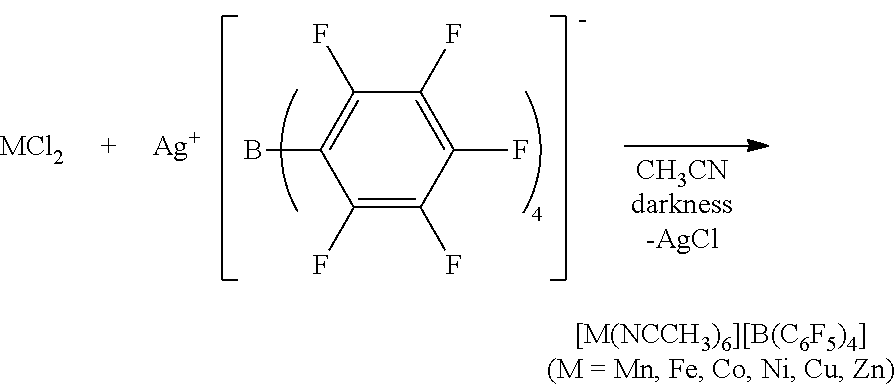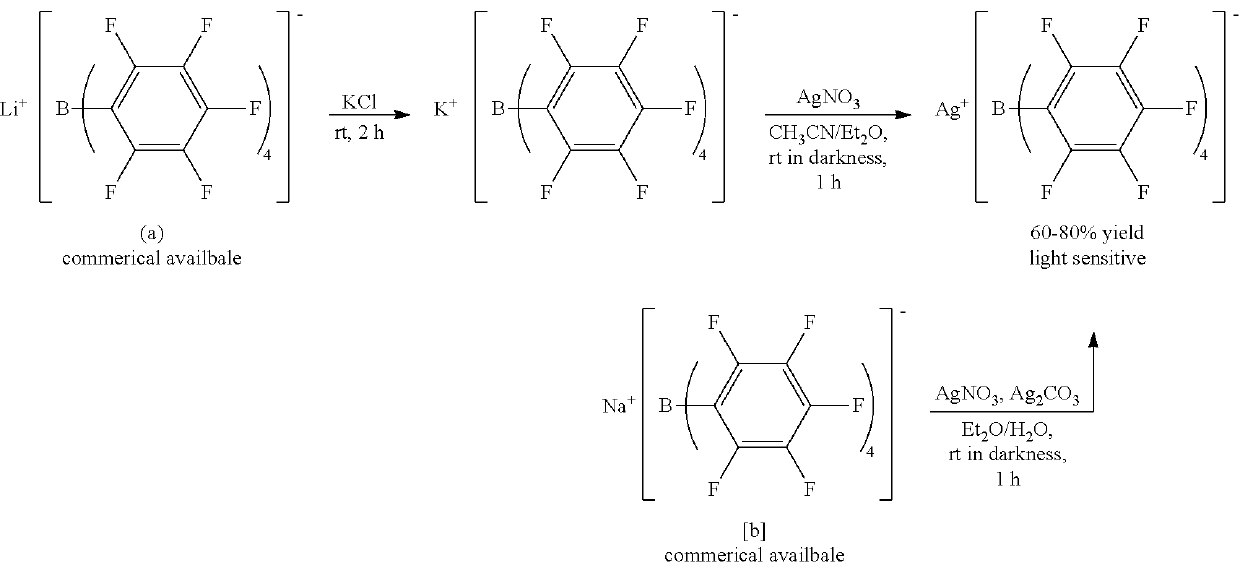Method for preparing transition metal complex
a transition metal complex and complex technology, applied in the field of transition metal complex preparation, can solve the problems of metal being easily oxidized, affecting the use of metals, and deteriorating catalyst activity, and achieves excellent polymerization activity, high molecular weight, and high economic feasibility.
- Summary
- Abstract
- Description
- Claims
- Application Information
AI Technical Summary
Benefits of technology
Problems solved by technology
Method used
Image
Examples
example 1
[0060]An anhydrous CH3CN (Aldrich Co.) dispersion (1 ml) of Mn(OAc)2 (OAc=an acetate group) (100 mg) (Alfa Aesar Co.) was prepared. 2 equivalents of [Et3Si][B(C6F5] (purchased from Asahi Glass Co.) with respect to the metal precursor was dissolved in anhydrous CH3CN (Aldrich Co.) (3 mL), and then added to the dispersion. The homogeneous mixture thus formed was stirred at room temperature for 5 hours. All solvents were evaporated under reduced pressure conditions, and remaining materials were washed with hexane. The resultant product was dried under reduced pressure conditions to obtain a powder type complex and stored at −30° C.
[0061][Mn(NCCH3)6][B(C6F5)4]2 (quantitative yield), Selected IR (KBr): νCN=2310, 2290 cm−1; elemental analysis calcd (%) for C60H18B2MnF40N6: C 43.43, H 1.09, N 5.06. Found: C, 43.29; H, 1.29; N, 5.14.
example 2
[0062]A powder type complex was obtained by the same method as in Example 1 except for using Fe(OAc)2 (Alfa Aesar Co.) instead of Mn(OAc)2.
[0063][Fe(NCCH3)6][B(C6F5)4]2 (quantitative yield), Selected IR (KBr): νCN=2312, 2285 cm−1; elemental analysis calcd (%) for C60H18B2FeF40N6: C 43.41, H 1.09, N 5.06. Found: C, 43.77; H, 1.21; N, 5.11.
example 3
[0064]A powder type complex was obtained by the same method as in Example 1 except for using Co(OAc)2 (Aldrich Co.) instead of Mn(OAc)2.
[0065][Co(NCCH3)6][B(C6F5)4]2 (quantitative yield), Selected IR (KBr): νCN=2316, 2287 cm−1; elemental analysis calcd (%) for C60H18B2CoF40N6: C 43.33, H 1.09, N 5.05. Found: C, 42.98; H, 1.31; N, 5.33.
PUM
| Property | Measurement | Unit |
|---|---|---|
| molar ratio | aaaaa | aaaaa |
| molecular weight | aaaaa | aaaaa |
| photosensitive | aaaaa | aaaaa |
Abstract
Description
Claims
Application Information
 Login to View More
Login to View More - R&D
- Intellectual Property
- Life Sciences
- Materials
- Tech Scout
- Unparalleled Data Quality
- Higher Quality Content
- 60% Fewer Hallucinations
Browse by: Latest US Patents, China's latest patents, Technical Efficacy Thesaurus, Application Domain, Technology Topic, Popular Technical Reports.
© 2025 PatSnap. All rights reserved.Legal|Privacy policy|Modern Slavery Act Transparency Statement|Sitemap|About US| Contact US: help@patsnap.com



